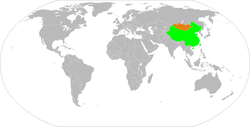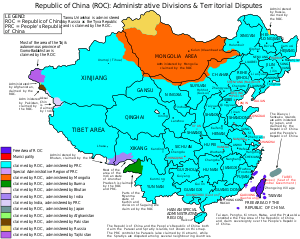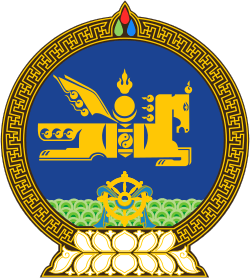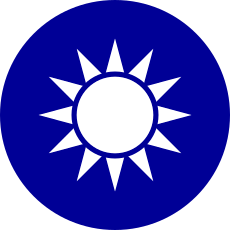Mongolia–Taiwan relations
 | |
Taiwan |
Mongolia |
|---|---|


The Republic of China did not recognise Mongolia until 1945. The countries did not exchange any diplomats between 1946 and 1949, and Mongolia recognized the People's Republic of China at the end of the Chinese Civil War in 1949.
In the absence of formal diplomatic relations between Mongolia and the Republic of China on Taiwan, the two countries have "Trade and Economic Representative Offices" which function as de facto embassies: Taiwan is represented by an office in Ulaanbaatar,[1] and Mongolia is represented by an office in Taipei.[2]
History
Before 1949
Throughout history, Mongolia and China have waged many wars. China's Great Wall was constructed to ward off invading hordes from Mongolia and Central Asia. Mongols under Kublai Khan conquered much of China and established the Yuan dynasty, and Mongolia later fell under control of the Qing dynasty of China.
With the fall of the Qing dynasty in 1911, Outer Mongolia declared independence after more than 200 years of foreign rule. The same year, the Republic of China was established following the Xinhai Revolution. Although many peoples of Inner Mongolia sought to accede to the new state, China retained its control over the area and invaded Mongolia in 1919.[3][4] Consequently, Mongolia sought Soviet Russian support to reclaim its independence. In 1921, Chinese and White Russian forces were driven out by the Red Army of the Soviet Union and pro-Soviet Mongolian forces. In 1924, the Mongolian People's Republic was formed.[3]
Under the terms of the 1946 Sino-Soviet Treaty of Friendship, the Republic of China recognised Mongolian sovereignty and independence.[5] However, due to a border conflict on the Khovd/Sinkiang border, no diplomatic relations were established in the 1946-49 period.
After 1949
In 1952, three years after the Republic of China's retreat to the island of Taiwan (which was taken from Japan in 1945), the ROC government accused the Soviet Union of violating the treaty. The following year, the Legislative Yuan voted to abrogate the treaty.[6] Taiwan continued to occupy China's seat in the United Nations (UN) until 1971 and used its position as a permanent member of the UN Security Council to block the admission of the Mongolian People's Republic into the UN throughout the 1950s.[7][8] The only veto cast by the ROC during its membership in the UN was in 1955, against the admission of Mongolia. Thus, Mongolia was excluded from the UN until 1960, when the Soviet Union announced that unless Mongolia was admitted, it would block the admission of all of the newly independent African states. Faced with this pressure, the ROC relented under protest.
The Legislative Yuan applied for a constitutional interpretation on 12 April 1993 to ask what the boundaries of the ROC national territory would be, while considering Outer Mongolia not included in the ROC territory.[9] However, the Judicial Yuan in its Interpretation 328 on 26 November 1993, called the constitutional territory beyond the reach of judicial review and thus avoided the question as whether Mongolia should be considered the constitutional territory of the Republic of China.[10]
Ninety-one years after Mongolia's first declaration of independence, Taiwan still did not recognise Mongolia as an independent country; official maps of the Republic of China still showed Mongolia as ROC territory. Relations began to change in 2002, when the Executive Yuan under the Democratic Progressive Party administration announced that Mongolian nationals would be entitled to visas rather than entry permits when travelling to Taiwan, the same as individuals from foreign countries. However, the Kuomintang-controlled Legislative Yuan criticized the implementation of the decision, as they had not been consulted.[11] Later, representatives of the two governments agreed to open offices in each other's capitals; ROC's office in Ulaanbaatar was opened in September of that year. ROC's Ministry of the Interior then decided to discontinue including Mongolia on its official maps of ROC territory, and on 3 October 2002, the Ministry of Foreign Affairs announced that ROC recognizes Mongolia as an independent country.[12]
In 2002, the ROC government excluded Mongolia from the definition of the "mainland area" for administrative purposes. In 2006, old laws regulating the formation of banners and monasteries in Outer Mongolia were repealed. However, the official borders of the ROC have not been changed to exclude Outer Mongolia[13] via a vote of the National Assembly (as required by the Constitution prior to 2005) or via a referendum (as required by the Constitution after amendments made in 2005). The official status of recognition is currently ambiguous, though in practice Mongolia is treated as an ordinary foreign power.
See also
References
- ↑ Taipei Trade and Economic Representative Office
- ↑ Ulaanbaatar Trade and Economic Representative Office, Ministry of Foreign Affairs (Republic of China)
- 1 2 "China-Mongolia Boundary" (PDF). International Boundary Study. The Geographer, Bureau of Intelligence and Research (173): 2–6. August 1984. Archived from the original (PDF) on 16 September 2006. Retrieved 16 June 2008.
- ↑ "Chinese Look To Their Neighbours For New Opportunities To Trade". International Herald Tribune. 1998-08-04. Archived from the original on 2008-02-20. Retrieved 2008-06-15.
- ↑ "Onward to Mongolia", Taiwan Review, 2003-01-01, retrieved 2018-02-06
- ↑ Liu, Weiling (1997-08-15), "Mongolian visitors draw attention to border debate", Taiwan Journal, retrieved 2010-01-04
- ↑ "Taipei Sources Hint Veto on Outer Mongolia", Washington Post, 1955-11-20, retrieved 2008-02-05
- ↑ "Taiwan Veto Likely; Taipei Regime May Again Bar Outer Mongolia From U.N.", The New York Times, 1961-04-22, retrieved 2008-02-05
- ↑ Legislative Yuan Constitutional Interpretation Application (in Chinese), Judicial Yuan, 1993-04-12, retrieved 2008-12-22
- ↑ Judicial Yuan Interpretation 328 translated by Professor J. P. Fa, Judicial Yuan, 1993-11-26, retrieved 2008-12-22
- ↑ "Major Taipei decision alters Mongolia's status", China Post, 2002-02-27, retrieved 2008-02-05
- ↑ "Mongolian office to ride into Taipei by end of the year", Taipei Times, 2002-10-11, retrieved 2008-02-05
- ↑ Yearbook of the Republic of China (中華民國年鑑): The land of the Mainland Area (in Chinese), Government Information Office of the Republic of China (Taiwan), 2005, archived from the original on 14 February 2008, retrieved 2008-12-22

